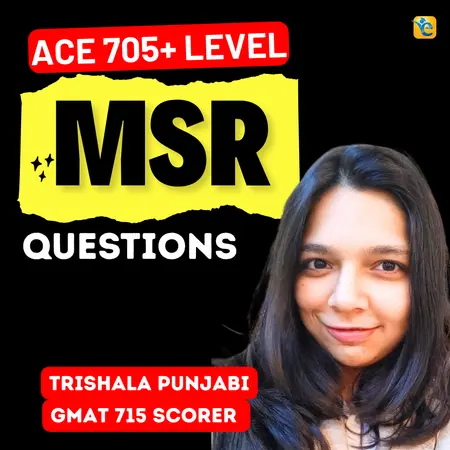Events & Promotions
|
|

GMAT Club Daily Prep
Thank you for using the timer - this advanced tool can estimate your performance and suggest more practice questions. We have subscribed you to Daily Prep Questions via email.
Customized
for You
Track
Your Progress
Practice
Pays
Not interested in getting valuable practice questions and articles delivered to your email? No problem, unsubscribe here.
- Nov 22
11:00 AM IST
-01:00 PM IST
Do RC/MSR passages scare you? e-GMAT is conducting a masterclass to help you learn – Learn effective reading strategies Tackle difficult RC & MSR with confidence Excel in timed test environment - Nov 23
11:00 AM IST
-01:00 PM IST
Attend this free GMAT Algebra Webinar and learn how to master the most challenging Inequalities and Absolute Value problems with ease. - Nov 25
10:00 AM EST
-11:00 AM EST
Prefer video-based learning? The Target Test Prep OnDemand course is a one-of-a-kind video masterclass featuring 400 hours of lecture-style teaching by Scott Woodbury-Stewart, founder of Target Test Prep and one of the most accomplished GMAT instructors.
gmatapprentice
Joined: 14 Nov 2018
Last visit: 21 Apr 2021
Posts: 50
Own Kudos:
Given Kudos: 211
Location: United Arab Emirates
Concentration: Finance, Strategy
Schools: LBS '22 (I)
GMAT 1: 590 Q42 V30

GMAT 2: 670 Q46 V36

GPA: 2.6
Kudos
Bookmarks
Bunuel
Im not getting how you formulate the below equation. Would request if you can elaborate.
1%x+2%y+3%z=1.5%(x+y+z)1%x+2%y+3%z=1.5%(x+y+z)
Im not getting how you formulate the below equation. Would request if you can elaborate.
1%x+2%y+3%z=1.5%(x+y+z)1%x+2%y+3%z=1.5%(x+y+z)
Kudos
Bookmarks
gmatapprentice
It's a direct translation of the stem:
Three grades of milk are 1 percent, 2 percent and 3 percent fat by volume. If x gallons of the 1 percent grade, y gallons of the 2 percent grade, and z gallons of the 3 percent grade are mixed to give x+y+z gallons of a 1.5 percent grade, what is x in terms of y and z?
x gallons of the 1 percent grade, y gallons of the 2 percent grade, and z gallons of the 3 percent grade are mixed: 1%x+2%y+3%z
...to give x+y+z gallons of a 1.5 percent grade: 1.5%(x+y+z)
dylanl1218

Current Student
Joined: 20 Oct 2018
Last visit: 07 Jun 2022
Posts: 40
Given Kudos: 246
Location: United States
Schools: Johnson '24 (A)
GPA: 3.5
Kudos
Bookmarks
When given mixture problems I prefer to solve these using a table approach, where each object has a row and the columns are set up as [Total volume, % of mixture, Target volume].
Ultimately the sum of the total volume multiplied by the given weighted percent = sum of the target volumes. With that in mind we can use the table to solve for X.

Ultimately the sum of the total volume multiplied by the given weighted percent = sum of the target volumes. With that in mind we can use the table to solve for X.










